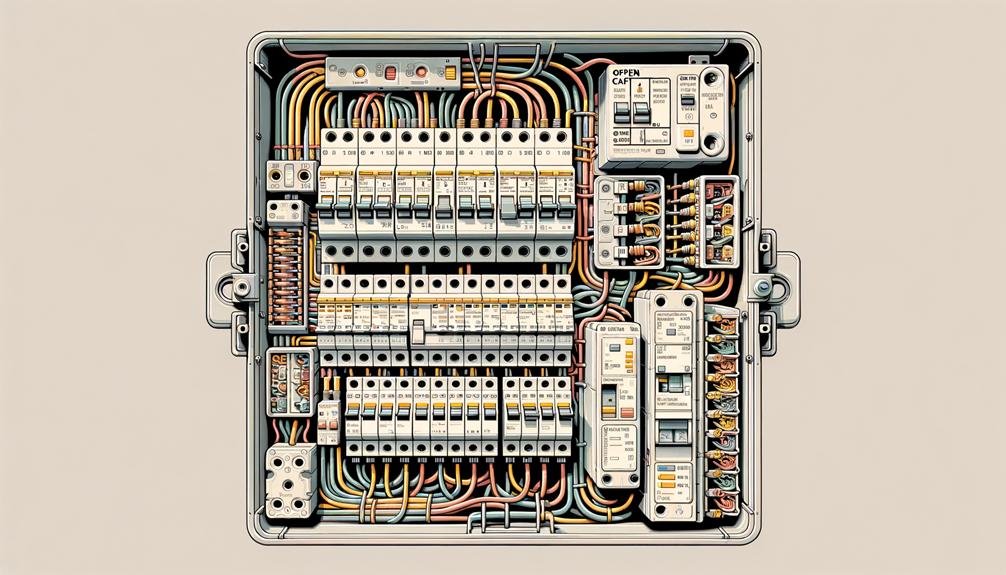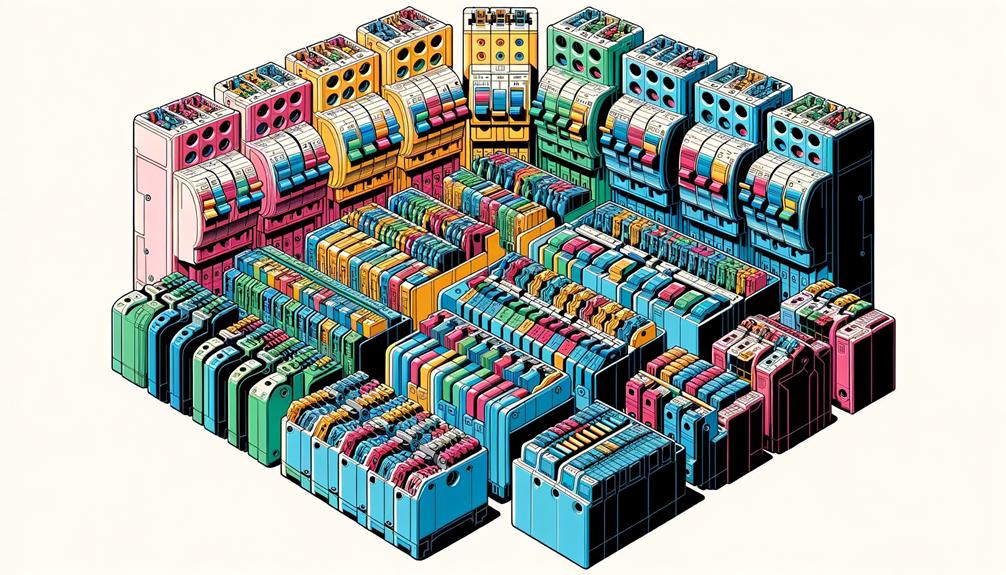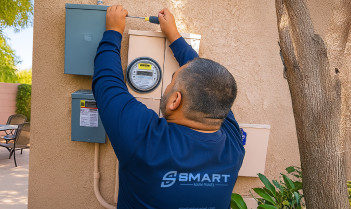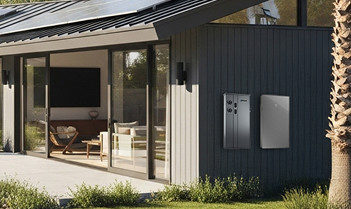Date
Types of Breaker Boxes
Just as the telegraph was a game changer in communication, the introduction of breaker boxes revolutionized electrical safety in homes and businesses. You might be familiar with the concept of breaker boxes, but do you know the different types and their unique functions? From standard circuit breakers to Ground Fault Circuit Interrupter (GFCI) and Arc Fault Circuit Interrupter (AFCI) breakers, each type offers a different level of protection against electrical hazards. We'll also touch on the more intricate Combination Arc Fault Circuit Interrupter/Ground Fault Circuit Interrupter (CAFCI/GFCI) breakers. It's essential to know your breakers, as choosing the correct type and size for each circuit ensures optimal protection and prevents potential hazards. Let's embark on this enlightening journey together, shall we?
Understanding Standard Circuit Breakers

Diving into the world of standard circuit breakers, you'll find three main types: standard, GFCI, and AFCI, each with unique functions and specific locations within your home to prevent electrical fires and monitor amp capacity. The types of breakers you'll find in your breaker panel depend on the electrical work done in your home.
Standard breakers, the most common breakers, come in single- or double-pole options. These basic circuit breakers are commonly found in homes' electrical panels. Single-pole breakers are prevalent, while double-pole breakers are necessary for large appliances.
In your circuit breaker box, you might also find GFCI breakers. These cut power to the entire circuit, providing ground-fault protection. They're essential in specific home locations like bathrooms or kitchens, where water could make contact with electrical devices.
Finally, AFCI circuit breakers are another important circuit breaker type. They guard against unintentional electrical discharges, a leading cause of electrical fires. Since the 2017 code update, these breakers are now required in all rooms of your home.
Understanding your home's breaker panel and the types of circuit breakers inside is crucial for maintaining a safe household.
Exploring GFCI Circuit Breakers

Having brushed up on the basics of standard circuit breakers, let's now shift our focus to the vital role of GFCI circuit breakers in maintaining electrical safety in our homes. GFCI, or Ground Fault Circuit Interrupter, is a critical component designed to protect you from electrical shocks.
Here are four key points about GFCI circuit breakers:
- Protection: These breakers cut off power to the entire circuit when a ground fault is detected, shielding you from potential electrical hazards.
- Necessity: GFCI breakers are mandatory in certain areas of the home, including bathrooms, kitchens, garages, and outdoor locations. This requirement eliminates the need for separate GFCI receptacles in these areas.
- Function: GFCI breakers trip due to overload, short circuit, or line-to-ground fault, instantly interrupting the current.
- Versatility: Not only are GFCI breakers essential for areas with water risks, but they're also now required for HVAC units.
Bear in mind the difference between GFCI and AFCI breakers. While both protect you, they serve different purposes. It's essential to understand the role of circuit breakers and GFCI in your home's electrical system to ensure your safety.
The Purpose of AFCI Circuit Breakers

Now, let's turn our attention to AFCI, or Arc-Fault Circuit Interrupters, another significant type of breaker that plays a crucial role in preventing electrical fires in your home. As one of the vital types of circuit breakers, AFCI circuit breakers are designed to protect electrical circuits from unintentional electrical discharges. They effectively disconnect damaged circuits before a potential fire risk emerges.
AFCI breakers monitor the current flowing in your circuits, specifically looking for arcs caused by worn or damaged cords and wiring. When these problematic arcs are detected, the AFCI breakers immediately intervene, cutting off the dangerous current. They are essentially the guardians of your home, providing an additional layer of fire safety by preventing loose connections from sparking fires.
The purpose of AFCI circuit breakers is to mitigate the risk of electrical fires, enhancing overall safety in your home. It's important to note that as per the 2017 code update and national building codes, AFCI and GFCI breakers are required in all rooms for new homes. They protect against a line-to-ground fault, ensuring a safer and more secure electrical system for you and your family.
Unpacking CAFCI Circuit Breakers

Let's delve into the world of CAFCI circuit breakers, a cutting-edge safety device that offers protection against both arcs and low-energy series arcing, making them an increasingly popular choice for downstream branch circuit wiring and power cords in modern homes. As part of the different types of circuit breakers, CAFCIs are designed to monitor and detect any abnormal current flow, enhancing your home's electrical safety.
- AFCI Circuit Breakers – These are another type of breaker that are designed to protect against arc faults and ground faults. They make a significant contribution to electrical safety.
- Dual Function Breakers – Combining CAFCI and GFCI, these breakers provide additional protection, covering more common circuits in your home.
- National Electrical Code Compliance – It's vital to ensure that your breakers comply with the National Electrical Code. This includes using CAFCI breakers in newly constructed homes or remodels where required.
- Main Breaker – The main breaker, another crucial type of breaker, controls the power supply to all the other breakers in your breaker box.
In a nutshell, CAFCI breakers are designed to offer comprehensive protection against arc faults, fulfilling an essential role in maintaining modern electrical safety standards.
Circuit Breaker Compatibility Tips

While understanding the types of breakers is crucial, it's equally important to know how to ensure their compatibility with your home's electrical system. You need to pay attention to the type of breaker that's commonly installed in your home. Is it a single-pole circuit breaker or a double-pole circuit?
Single-pole breakers are commonly installed in residential homes. They're designed to handle standard circuits, such as those found in your lighting and receptacle branch circuit. On the other hand, double-pole circuit breakers are used for appliances that require more power, such as your air conditioning system or electric oven.
Furthermore, some circuits may require Arc Fault Circuit Interrupter (AFCI) circuit breakers. AFCI breakers protect against electrical fires by monitoring the electrical waveforms in the circuit and tripping when they detect an arc fault.
Lastly, always ensure that the breaker you're installing matches the brand and type of your existing panel. Different manufacturers have different designs and using incompatible breakers may lead to poor performance or even safety hazards. So, it's crucial to check the compatibility of your circuit breakers to ensure the safety and efficiency of your home's electrical system.
Frequently Asked Questions
What Are the 4 Types of Electrical Panels?
You're asking about the four types of electrical panels. They are main breaker panels, main lug panels, transfer switches, and sub-panels. Each has distinct uses and is crucial for managing your home's electrical system.
What Are the 3 Types of Breakers?
You're dealing with three main types of breakers: standard, GFCI, and AFCI. Standard ones handle basic tasks, while GFCI protect from ground faults. AFCI breakers prevent unintentional electrical discharges, reducing fire risks.
How Do I Know What Kind of Breaker Box I Have?
You can identify your breaker box type by inspecting its label or manual, which typically states the model and type. If you're unsure, it's best to consult a licensed electrician for proper identification.
What's the Difference Between Breaker Box and Breaker Panel?
In the electrical world, a breaker box is your home's power hub, while the breaker panel is its control center. The box houses everything, but the panel specifically hosts the individual circuit breakers.
Conclusion
In the realm of electrical safety, it's crucial to understand the different types of breaker boxes. Did you know that electrical malfunctions cause 51,000 house fires each year? These can be drastically reduced by using the proper breaker. Whether it's a standard, GFCI, AFCI, or CAFCI breaker, each has a role in safeguarding your home. Always ensure compatibility for optimal protection. Knowledge is power, and in this case, it could be a lifesaver.



